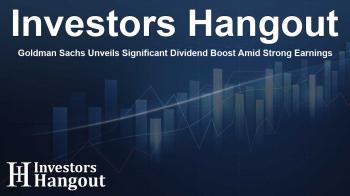Goldman Sachs Unveils Significant Dividend Boost Amid Strong Earnings

Goldman Sachs Announces Major Dividend Increase
Goldman Sachs (NYSE: GS) has made headlines recently with its impressive earnings report for the second quarter. The investment bank saw remarkable financial performance, surpassing expectations and further solidifying its position in the market.
The company raised its quarterly dividend by a substantial 33%, elevating it from $3.00 to $4.00 per share. This significant increase marks the first time the bank has enacted such a leap since its previous raised dividend in 2021, which was a response to the economic rebound following the pandemic.
Impact on Shareholders
This dividend hike translates to a yield increase from approximately 1.71% to 2.28%. This change promises to deliver additional financial rewards for shareholders, demonstrating Goldman Sachs' ongoing commitment to returning value to its investors. Furthermore, the company maintains a modest payout ratio of 27%, indicating potential for future increases in dividends as profitability continues to grow.
“Our board approved a 33% increase in our quarterly dividend to $4 a share, which underscores our confidence in the durability of our franchise,” stated David Solomon, Chairman and CEO of Goldman Sachs. “Since 2018, we’ve increased our quarterly dividend by 400%.”
Strategic Growth Focus
Solomon discussed the conscious strategy behind this dividend adjustment, noting the firm's intention to align more closely with other leading financial institutions. He acknowledged that unlike some competitors that began from a lofty dividend point, Goldman Sachs started from a different perspective and has been gradually working up.
“Five, six, or seven years ago, we had a nominal dividend and now we’ve been growing into it as we’ve been expanding the firm,” he added.
While Solomon indicated that investors should not anticipate such drastic increases every quarter, he assured stakeholders of Goldman Sachs’ commitment to maintaining a progressively growing dividend.
“There is room for us to continue to drive that dividend higher,” he emphasized.
Remarkable Financial Performance
The recent dividend rise came alongside a robust performance report detailing quarterly revenues of $14.6 billion for Goldman Sachs, marking a 15% uptick compared to last year. This result smashed analyst projections which anticipated revenues of $13.5 billion.
In the same vein, net earnings surged by 20%, reaching $3.5 billion or $10.91 per share—significantly exceeding forecasts of $9.53 per share.
The firm’s global banking and markets segment contributed majorly to this revenue, bringing in approximately $10.1 billion with a notable year-over-year increase of 24%.
As a leader in mergers and acquisitions, Goldman Sachs achieved $2.2 billion in investment banking fees, representing a 26% growth from the previous year, while also noting an increase in deal backlogs for five consecutive quarters.
“The metrics indicating backlog and new business opportunities are on the rise,” noted Solomon. “It feels like we’re entering a period of heightened activity.”
The firm also set a record for equity trading revenue, totaling $4.3 billion—a remarkable 36% increase year-over-year, attributed to clients adjusting their portfolios amid a volatile yet robust environment for stocks.
Market Outlook and Analyst Sentiments
Goldman Sachs stock has received favorable price target adjustments from financial firms such as Keefe Bruyette and Wells Fargo, following the latest earnings report. Analysts foresee an improving climate for the investment bank aided by regulatory changes and a revitalized M&A market.
Currently, analysts project a median price target of $704 per share, which is just slightly above its existing price of $701. The stock has already demonstrated significant growth, appreciating by 22% year-to-date and 39% over the past year, all while maintaining a reasonable valuation at 16 times earnings.
My perspective aligns with that of Wells Fargo and Keefe Bruyette, which predict around 10% upside for Goldman Sachs’s stock. Added to this potential is the boost from the substantial dividend increase, which is sure to draw in investor interest.
Frequently Asked Questions
What was Goldman Sachs' recent dividend increase percentage?
Goldman Sachs increased its dividend by 33%, raising it from $3.00 to $4.00 per share.
How did Goldman Sachs perform in Q2 financially?
In Q2, Goldman Sachs reported revenues of $14.6 billion and net earnings of $3.5 billion, exceeding analyst expectations.
What is the current yield for Goldman Sachs after the dividend hike?
The yield has risen to approximately 2.28% following the recent dividend increase.
What are analysts saying about Goldman Sachs stock?
Analysts have set a median price target of $704 per share, indicating potential for continued stock growth.
What are the future prospects for Goldman Sachs's dividends?
The company's low payout ratio and commitment to increasing dividends suggest continued growth in future distributions.
About The Author
Contact Logan Wright privately here. Or send an email with ATTN: Logan Wright as the subject to contact@investorshangout.com.
About Investors Hangout
Investors Hangout is a leading online stock forum for financial discussion and learning, offering a wide range of free tools and resources. It draws in traders of all levels, who exchange market knowledge, investigate trading tactics, and keep an eye on industry developments in real time. Featuring financial articles, stock message boards, quotes, charts, company profiles, and live news updates. Through cooperative learning and a wealth of informational resources, it helps users from novices creating their first portfolios to experts honing their techniques. Join Investors Hangout today: https://investorshangout.com/
The content of this article is based on factual, publicly available information and does not represent legal, financial, or investment advice. Investors Hangout does not offer financial advice, and the author is not a licensed financial advisor. Consult a qualified advisor before making any financial or investment decisions based on this article. This article should not be considered advice to purchase, sell, or hold any securities or other investments. If any of the material provided here is inaccurate, please contact us for corrections.

